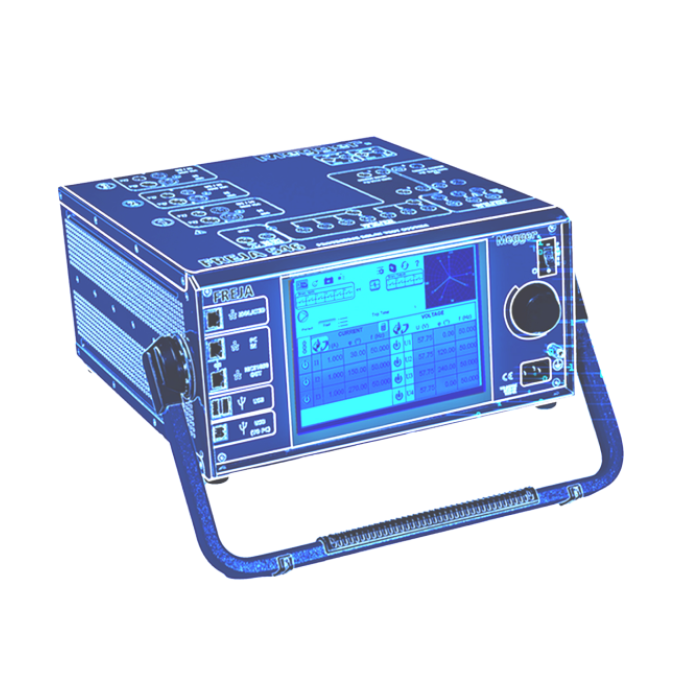New
FREJA and SMRT Digital Twin high fidelity simulator
Test before you install to reduce stress during time constraints
With the digital twin, you can test and approve relay settings prior to factory acceptance testing (FAT) or commissioning, saving you time when you commence real-world tests.
Enables virtual relay testing
Designed to test Siemens SIPROTEC DigitalTwin relays.
Created test plans that can be reused for real-world testing
You can reuse test plans created for virtual relays when testing physical devices to save time and increase efficiency. It’s worth noting that only a subset of the test plans need to reused, just enough with tests to ensure proper connections and fully functional hardware.
Useful training tool, enhancing clarity and reducing human error
Train employees based on their exact needs, either remotely or on-site, without the need for a dedicated training room equipped with a full range of test devices.
All safety-related risks are negated using a digital twin relay test set
As you can work virtually, there are no hazardous voltages present and performing an incorrect connection or other error will not damage the equipment or cause it to become dangerous.


About the product
The FREJA and SMRT Digital Twin is the first of it’s type to be created and is a functional digital twin of Megger's relay test systems, FREJA and SMRT. This pioneering technology enables you to virtually test Siemens SIPROTEC 5 devices through Siemens’ cloud-based SIPROTEC DigitalTwin. The relay tests are performed online, before the physical devices are accessible, and with tested and approved protection settings, only a subset of the tests need to be repeated on the physical devices to ensure correct input and output hardware and connections.
FAQ / Frequently Asked Questions
The Super Digital Twin can be used to simulate complex scenarios involving multiple feeders and phases. For instance, it can be used to test busbar protection with a high number of analogue channels.
The Super Digital Twin (Super DT) provides a virtual test set with additional analogue signals and binary outputs. This expanded capacity allows for more intricate and complex testing scenarios that may not be feasible in physical testing.
The manufacturer of the physical twin should create the digital twin because they possess the unique knowledge and expertise required to virtualise their own intellectual property and configuration files accurately. This enables them to replicate the behaviour, settings, and logic of their physical product in a digital format. By creating the digital twin themselves, manufacturers ensure that the virtual counterpart closely mirrors the real-world behaviour of their product. This alignment allows for effective reuse of configuration data on-site with real equipment, promoting consistency and accuracy between the physical and virtual versions of the product.
The SIPROTEC DigitalTwin environment imports the generated COMTRADE file. It establishes a virtual connection between the relay's inputs and the test set’s outputs, allowing engineers to assess the relay's behaviour based on the simulated data.
A validated test file refers to a test file that has undergone thorough testing and verification to ensure that it performs the intended test accurately. In essence, a validated test file reliably and precisely replicates the test conditions and scenarios or which it was created. These files provide engineers with the advantage of using pre-validated test scenarios which can be executed from the physical twin for accurate testing, leading to streamlined and consistent testing processes.
In virtual testing, the relay inputs receive digital signals stored in a specific COMTRADE file format. These signals are then processed by the Digital Twin relay, and the responses are analysed using event recorders, disturbance recorders, or the relay's Human Machine Interface (HMI).
Open loop testing is conducted to evaluate and verify various aspects of relay performance and operation. It enables assessment even without interaction between the Digital Twin relay's binary outputs and the Digital Twin test sets binary inputs.
By employing digital twins, the need for extensive physical testing during factory acceptance testing is diminished. This results in significant time and resource savings while maintaining a high level of accuracy in the testing process.
Virtual commissioning involves conducting tests virtually, rendering subsequent on-site commissioning tests a subset of these virtual tests. This streamlined approach enhances the testing process and reduces the need for physical presence and on-site interventions.
To function effectively, digital twins of protection relays and relay test sets must share the same data. This data exchange is typically facilitated through software tools to ensure accurate and seamless information transfer between the virtual counterparts.
In the realm of power system protection testing, digital twins are functional replicas of physical components, such as protection relays and relay test sets. Digital twins enable engineers to conduct virtual relay protection testing, creating a digital environment where a wide range of testing scenarios can be simulated without the need for physical presence or hardware. This technology facilitates precise evaluation, validation, and enhancement of protection systems while mitigating the limitations of traditional physical testing methods.
Yes, a Megger digital twin license and Siemens license are required.
At the moment, the following relay test sets are available as digital twins: SMRT1, SMRT46, SMRT410, FREJA546, and FREJA549.
Also available is the Super Digital Twin (Super DT). The Super DT is not a single physical instrument, but a combination of daisy-chained FREJA/SMRT devices to reach the current and voltage channels offered by the Super DT (see the FAQ about Super DT).
Digital Twins in power system protection testing offer advantages such as efficient and accurate virtual testing, reduced need for physical presence, and cost-effective testing processes. They enable engineers to validate protection systems without the constraints of physical testing.
Further reading and webinars
Troubleshooting
If the “Megger Digital Twin Test Set” button does not appear when entering the connection screen, please make sure you have a PowerDB version 11.2.10.130 or later and that your Digital Twin license is activated.
You activate the Digital Twin in the RTMS software. Click on the “System configuration” icon and go to the system tab and click the “Megger licensing” button. There, you will need to enter your Digital Twin serial number.
Note: Internet connectivity is required to activate the license.
If you haven’t got the license, you will need to source it from Megger, either with a monthly (part number 1015-22MON) or annual (part number 1015-22) subscription.
Normally, you select the type of digital twin when you connect, but it is possible to change inside the application by clicking on the “Change instrument” icon. You will then be able to select the instrument you want to simulate from the list.
Interpreting test results
The digital twins perform what is called open-loop test. In this test, there is no feedback loop to the test instrument. With that said, the results and the relay response are viewed at the relay digital twin front panel or in the disturbance recorder.
The specific values for the tolerances should be provided in the relay's manual or from the local test procedures. Since it is an open-loop test, the results are provided in the disturbance recorder.













